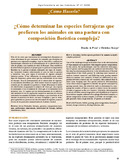Mostrar el registro sencillo del ítem
¿Cómo determinar las especies forrajeras que prefieren los animales en una pastura con composición florística compleja?
| dc.contributor.author | Skarpe, Christina | |
| dc.contributor.author | Pezo Quevedo, Danilo | es_ES |
| dc.date.accessioned | 2015-03-19T22:16:56Z | |
| dc.date.available | 2015-03-19T22:16:56Z | |
| dc.date.issued | 2009 | |
| dc.identifier | 473924 | es_ES |
| dc.identifier.issn | 1022-7482 | es_ES |
| dc.identifier.uri | https://repositorio.catie.ac.cr/handle/11554/6937 | |
| dc.description.abstract | Aquí se describen y analizan las metodologías utilizadas en la determinación de la selectividad, no sólo de plantas, sino también de sitios de forrajeo. Para establecer la selectividad en general, el primer paso es precisar la composición florística en la pastura evaluada utilizando dos tipos de transectos: transectos control, seleccionados al azar en toda la pastura y transectos vaca, para seguir el recorrido de algunos animales mientras pastan. Si hay diferencias en composición entre ambos tipos de transectos, quiere decir que hay selectividad de los sitios de forrajeo. Para la determinación de la selectividad de especies, se recomienda identificar por observación visual las especies consumidas por los animales en pastoreo y luego determinar el índice de selectividad, comparando el número de veces que una especie es consumida versus el número de veces que se la encuentra en el transecto vaca. | es_ES |
| dc.description.abstract | In this article, the methodologies used for selectivity determination of species and foraging sites are analyzed and described. The first step for determining selectivity is the identification of floristic composition of the whole pasture by selecting some transects at random (control transects) and following some grazing animals chosen at random (cow transect). If there are differences in composition between control and cow transects, then animals tend to select some foraging sites. For species selectivity determination, visual observation is suggested to identify the species consumed by grazing animals then, the selectivity index is determined by comparing the number of times a species is taken versus the number of times it appears in the cow transect. | en_EN |
| dc.format.mimetype | ||
| dc.language.iso | es | es_ES |
| dc.publisher | CATIE, Turrialba (Costa Rica) | es_ES |
| dc.relation.ispartof | Agroforestería en las Américas, número 47 (2009), páginas 85-93 | |
| dc.rights | info:eu-repo/semantics/openAccess | es_ES |
| dc.rights.uri | https://creativecommons.org/licenses/by-nc-nd/4.0/ | |
| dc.subject | TIERRAS DE PASTOREO | es_ES |
| dc.subject | PASTIZALES | es_ES |
| dc.subject | COMPOSICION BOTANICA | es_ES |
| dc.subject | PREFERENCIAS ALIMENTARIAS | es_ES |
| dc.subject | EFICIENCIA DE CONVERSION DEL PIENSO | es_ES |
| dc.subject | NICARAGUA | es_ES |
| dc.subject | PASTOREO | es_ES |
| dc.title | ¿Cómo determinar las especies forrajeras que prefieren los animales en una pastura con composición florística compleja? | es_ES |
| dc.title.alternative | How to determine fodder species preferred by animals in highly complex pastures? | es_ES |
| dc.type | Artículo | es_ES |
| dc.journal.issueNumber | 47 | |
| dc.journal.pages | 85-93 |



